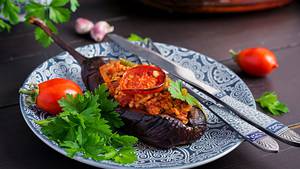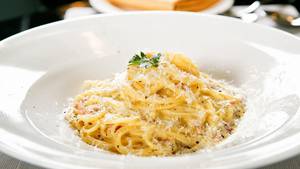The vision of Bordeaux as exclusively a white linen restaurant wine has passed. A new generation of sommeliers are opening up the door for Bordeaux to be served in a more casual setting. From a Bordeaux-based cocktail to even a pasta and Sauternes pairing, Canadian sommeliers are looking for new ways to bring Bordeaux to the table, exploring new pairings and matching Bordeaux wines to local flavours.
The Royale Riff: Crémant de Bordeaux cocktail
Matt Landry, British Columbia, Runner-up Best Sommelier of Canada 2020
Crémant de Bordeaux
In the mind of wine consumers, Bordeaux evokes a number of great images of grand chateaux, rare wine, and hearty foodstuffs. One could be forgiven, however, for not knowing that Bordeaux produces a fair amount of quality sparkling wine under the Crémant de Bordeaux appellation. Produced via the traditional method, it utilizes the region’s famous grapes – Cabernet, Merlot, Sauvignon Blanc, Sémillon – to produce both white and rosê bubbles. Given its affordable price, I like to utilize Crémant de Bordeaux in cocktails.
A simple option is the Cru Royale, a quick riff on the Kir Royale.
Cru Royale
1oz Lillet*
4 oz Crémant de Bordeaux
Directions: In a flute glass, begin with the Lillet before adding the Crémant. I prefer to use a white version of Crémant de Bordeaux, however the pink kind works as well. Finish the cocktail with a lemon twist garnish.
Great Graves Whites, Po Food
Mark DeWolf, Nova Scotia, Past-President CAPS
Whenever I pour myself a glass of the Sauvignon Blanc and Sémillon-based wines that emerge from the gravel and pebble-tinged soils south of the city of Bordeaux I am tasting an ensemble of flavours and textures that could be seen as contrary to each other. Yet, within their glass confines, the diversity combines to create a liquid that defies conventions: one that is both classic and modern, and at once a masterpiece of both power and subtlety, joyfulness and thoughtfulness.
The oak fermented and aged whites of ‘Péssac’ are harmonious blends of Sauvignon Blanc and Sémillon, sometimes supported by the prettiness of Muscadelle and the rich, albeit minor role of Sauvignon Gris. In their youth, I often find the herbal, citrus and vivacious character of Sauvignon Blanc takes centre stage, while Semillon’s initially more subtle performance rises to a crescendo of beeswax and honeyed orchard fruit flavours over time. While the stars of the performance are its central cast, these wines’ oak settings offer no less of a performance, as the most prestigious white wines of Pessac-Léognan tendency to be fermented and aged in barriques, whilst prevented from undergoing malolactic, creates a textured but the not overpowering backdrop for Sauvignon and Sémillon’s varietal character.
As for the pairings, the juxtapose of flavours provide chefs and sommeliers alike so many opportunities. While the Bordelais like to wash down a plate of local oysters with fresher, crisper styles of wines from the region, I’d suggest the textural richness of the more premium Pessac wines lends well to a truly North American version treatment of these salty, sweet bivalves. Oyster loaf, a sandwich made with a soft doughy style of baguette and topped with fried oyster became popular in the south in the late 1800s. Later the po’boy sandwich, made using the same bread, but giving more options of meat and other fried shellfish became a signature dish of Cajun culture (itself a blend of Acadian (French Canadian) and the Southern United States) and cheap nourishment for the working class.
As for the pairing, the oak elements of the wines a harmonious combination to the toasty elements of the grilled bread, the saline nature of the oysters a fine marriage with the fresh acidity of wines, and the curry mayonnaise tempered and embraced by the fruit contribution of the Sémillon.
Oyster Po’Boy & Frites
Pairing: Pessac-Léognan
4 Servings (appetizer), 2 Servings (main course)
24 oysters, shucked
1 cup seasoned flour
2 egg + 1 tbsp water, beaten
1 1/2 cup panko
Fresh thyme (optional)
Vegetable oil
2 small dough baguette, halved, toasted
Curry mayonnaise
Microgreens, for garnish
Lemon wedges
Directions: Place flour, egg wash and panko in individual bowls. Add a little more flavour by adding fresh thyme to your panko but consider this an option, not a rule. One by one dip an oyster in flour, then egg wash and then cover in panko. Repeat until all oysters are crusted with panko. Place a deep-sided pan over medium-high heat. Add enough oil to cover the bottom of the pan. When oil begins to smoke, add the oysters. Fry them until golden brown on each side. From pan and set on paper towel to drain excess oil. Place 1 to 2 tablespoons of curry mayonnaise on a slice of baguette. Top with 6 oysters and a handful of microgreens. Squeeze a lemon wedge over top and season with salt. Top with another slice of baguette. Repeat.
*To make the mayonnaise, whisk 1 egg yolk and 1 tablespoon lemon juice until well combined. Slowly whisk in 1 cup of olive oil. Add 1 tsp curry powder and 1 tsp honey and mix. Season with salt and pepper to taste.
Médoc Elegance & Canadian Treasures
Felix Faundez-Rubio, Manitoba, Runner-up Best Sommelier of Manitoba 2021
The elegance and complexity of Bordeaux red wines cannot be debated when sipping a blend of Cabernet Sauvignon, Merlot and Cabernet Franc often adorned with varying amounts of Petit Verdot, Carménère and/or Malbec. The Médoc area, on the left bank of the Gironde estuary, is dominated by Cabernet Sauvignon, a grape with a character that demands a dish able to withstand its intensity. Here is where rich meats like beef, lamb, venison and, in this case, mighty bison, all go on stage.
The tannic structure of Cabernet Sauvignon and the plush texture of Merlot in the blend presents an appropriate match to the richness of the proteins these meats bring to the palate. The bold character of these “left bank” blends allows for an interaction that coats the mouth and at the same time cleanses all traces of the fat content natural to the food. A Canadian-style burger, even in its simplicity, can certainly provide the right flavours to enjoy with a revered wine.
The strength of young Bordeaux blends has traditionally been softened by the use of oak ageing, for which 12 to 18 months is not unusual. The contact of the wine with the wood confers structure and flavour upon it, which is usually perceived in the nuances of vanilla, spice and brown sugar on the most approachable side of the spectrum. Canadian-treasured maple syrup on mouth-watering bacon becomes one with such flavours from the wood, as well as the black pepper already integrated with the burger.
For a graceful finish, usually experienced in the Bordeaux blends with herbaceous notes such as garrigue and mint, the addition of rosemary and chopped mint in the burger is the refreshing touch that calls for a next bite and another sip.
Traditions and old ways always find new horizons. This is how a dish from this side of the pond can bring French favourites a flavourful alternative that, far from taking away refinement, adds sophistication.
Bison Burgers with Maple Glazed Bacon and Cheddar
1 lb ground bison chuck
2 tbsp fresh mint, finely chopped
2 oz Sherry
1 tbsp Worcestershire sauce
1 shallot, minced
2 garlic cloves, minced
1 tsp cracked black pepper
1 tsp salt
4 hamburger buns
8 slices bacon, drizzled with maple syrup
Aged white Cheddar
1 tomato, sliced, for garnish
Mint, chopped, for garnish, optional
Directions: Preheat your barbeque to medium. Combine the ground bison with all other burger ingredients in a large bowl and mix thoroughly. Form the ground bison mixture into four equally sized patties. Cook the burgers for approximately 7 minutes per side or until the juices run clear. Remove the burgers from the grill. Place the burgers on hamburger and garnish with the maple glazed bacon, cheddar, tomato and any other toppings. Freshly chopped mint will add a further connection to the Cabernet component of the blend.
Exploring the Right Bank, the Right Way!
Right Bank and Curried Oxtail
by Christopher Wilton, Ontario, Durham College, Wilton Wine Consulting
The first time I understood fine wine was by drinking a bottle of 1997 Vieux Château Certan Pomerol. It was only seven years old by the time it got to me, but it was stunningly good, and I was transported. My recently kindled wine odyssey took on a new urgency as I pushed the boat out, determined to repeat that exhilarating experience again. Alas, as the tippled ones say, "there are no great wines; only great bottles,” and that search can turn as frustrating as it can delightful.
The journey from grape to glass can be a long one, indeed. When the grapes come out of the blocks, they're almost uniform, in a line, but then very quickly begin to differentiate and separate themselves in the vineyard, in the tank, and then in many cases, in the barrel. The longer they go, the more distinct that wine that came from the same origin will appear to us. In the end, the loneliness of the long-distance bottle will see all that difference amplified. In 20-year time, we can blind taste 10 bottles of the same wine and the same vintage (and often from the same cellar) and believe them to be 10 wines from 10 different places, grapes, and vintage.
From Bourg to Blaye, to St-Émilion and its many satellites; from Fronsac and Canon-Fronsac to Pomerol and Lalande-de-Pomerol and to the Francs- and the Castillon-Côtes de Bordeaux and to Graves de Vayres and Ste-Foy-Bordeaux across the Dordogne, Right Bank Bordeaux is distinguished by several different terroirs but only by one ever-present grape variety: Merlot.
The plummy density of Merlot and the easy way it’s turned into wine the world over has washed out its reputation with many drinkers. Many fans of the grape know, however, that Merlot can reach sublime heights in a familiar three-act play in Bordeaux. Particularly, and especially, in the Right Bank where it takes centre stage, supported by either Cabernet Franc or Cabernet Sauvignon; frequently both and seldomly by the other Bordeaux bit players of Malbec and Petit Verdot For now, their approval is limited to the Bordeaux & Bordeaux Supérieur appellations, and the Right Bank still means Merlot for the foreseeable future.
When sommeliers think of what to pair Right Bank Bordeaux with, the classic Entrecôte à la Bordelaise is the first thing that comes to mind. Entrecôte is traditionally prepared by using bone marrow in the rich and velvety red wine and shallot sauce and that technique is mirrored here in this hearty oxtail stew.
As the weather turns cold here in Ontario, our multi-cultural kitchens reach for the comforts of home. Just as different cultures mix and exchange in the kitchens of the GTA, this dish of Braised Oxtail from my Cape Malay community of South Africa is a wonderful example of a hybrid cuisine; the Indian current of spice merging with the Atlantic Britishisms of Worcestershire and mustard and whole stewed veg all done with the slow cooking of a Dutch oven.
How does a Right Bank Bordeaux play with this dish?
The weight of the dish, with its rich sauce from the bone and stewed vegetables matches the medium-full alcohol weight and richness of the red wine but is also contrasted by the coolness and refreshing acidity of a Right Bank red served at the proper temperature of 16C, setting the stage for a dynamic interplay between the two.
The acidity of the tomato, mustard, and Worcester (easily replaced in the recipe with red wine) is supported by the natural acidity of the wine, allowing the flavours to step through the rich velvet curtains of the sauce. At the same time, the ripe plummy fruit of the wine finds a friendly echo in the sweetness of carrot and the touch of apricot chutney, while the fine-grained tannins of the wine give a lush texture which stitch seamlessly together with the silky sauce.
The balanced alcohol of the wine has enough power to carry the flavours through to the back of the room but not so much that it becomes shrill and overpowers the orchestra.
A little bottle age and time spent in oak will further tie the knot tighter with the added umami of the Worcester, tomato and the Maillard compounds of the browned meat.
The complexity of the spices in the dish contrasts with the aromatic complexity of the wine. Bordeaux benefits from being a blend of grape varieties but also offers key lactones from oak-aging that are echoed specifically in the clove accent of this dish. This complexity is fundamentally one of contrasts and not matching because each spice and aroma stands out like its own colour in a larger, composed whole.
Right Bank Bordeaux is no longer restricted to a minimalist stage but is on its own journey, finding friends in the kitchens of the world!
South African Braised Oxtail
2kg Oxtail
2 tsp salt
6 tablespoons of oil
2 large (3 medium) onions, diced
1 large carrot, diced
2 cloves
1 tbsp cumin seed
1 tbsp coriander seed
8 garlic cloves, minced
1 tbsp paprika
1/2 tsp nutmeg
1 tbsp dried thyme (or 4 sprigs fresh)
2 fresh green chillies (depending upon desired heat), de-seeded and chopped fine
2 medium tomatoes, diced
Salt & pepper, to taste
6 medium potatoes, peeled, quartered
6 medium carrots, peeled, chopped into 2” pieces
1 bay leaf
2 tbsp Worcerstershire sauce
1 tbsp Dijon or other grainy mustard
1 tbsp apricot chutney (Mrs. Ball’s)
Hot water if necessary
Fresh coriander leaves
Directions: Season the oxtail pieces with salt and pepper. In a heavy-bottomed (cast iron) pot, heat oil over medium-high heat and brown the oxtail on all sides; remove from the pot and set aside. Turn the heat to medium and toast clove, cumin, and coriander seed briefly, then add the onion and carrot, allowing them to sweat. Next, add garlic and stir shortly until fragrant, following with dried/powdered spices and the chopped chillies if desired, and fry until the aroma fills your kitchen. Add water if too dry. Add diced tomato and sautée until colour deepens. Then add the potatoes and carrots, sautéeing shortly. Next, add the bay leaf, Worcester, mustard, and chutney and stir to combine. Salt and pepper to taste. Add the oxtail and any juices back in. Top with enough water as necessary to not quite cover the oxtail. Bring to a gentle boil, then cover and turn down low and let braise for 3-4 hours or until the meat is fork-tender, stirring occasionally, and adding more hot water as needed to keep levels up. The sauce should be velvety, so remove the lid and reduce if too thin. Remove thyme stalks, bay leaves, and cloves. Garnish with fresh coriander and serve over polenta or mash with a braised veg like spinach or baby bok choy on the side.
Sauternes and Pasta?
A Sweet Departure from Tradition
by Scott Cowan, Newfoundland, Best Sommelier of Atlantic Canada
The producers of Sauternes are a back-slapping and genial lot. When asked what they eat with their wine they may laugh and say, "oysters" or even "spicy Indian." Recently at Mallard Cottage we discovered an affiliation between Château Guiraud and pasta by dialing in on a few bridge ingredients. For this dish, we are doing an iteration with street corn. Opt for racier vintages like 2011 and 2015 for savory Sauterne pairings or turn to nearby Barsac for something more lithe (Château Daisy Daëne). With all of that said, the spirit of these masters cries out for tweaked take-out and food trucks instead of foie gras. The secret is to utilize contrasting ingredients (salt) and high impact techniques (smoking and confit) and steer away from excessive natural sugar, so as to not make it cloying. Sauternes is, after all, hedonistic, if not lighthearted.
Street Corn and Squash Linguine
Recipe by Chef David Woods
4 to 6 Servings
5 heads garlic, whole
3 cups heavy ream
2 white onions, roughly chopped
1 tbsp peppercorns
1 bay leaf
¼ cup + 2 tbsp white wine
4 ears corn
1 butternut squash, peeled, seeded diced
Roasted garlic oil*
12 oz fresh linguine
1 tbsp butter
1 shallot, finely diced
1 clove garlic, minced
Blue cheese**, crumbled, for garnish
Toasted pepitas (pumpkin seeds), for garnish
Watercress, or other sprouts, for garnish
Directions: Add heads garlic, cream, white onions, peppercorns, bay leaf and 1/4 cup white wine to a pot. Bring to a boil and then reduce to a simmer. Simmer for 3 hours. Strain. Pull pack corn husks and remove silk. Add corn to a brine solution (water, salt, sugar, spices) for 3 hours. Tie husks, using kitchen twine, to corn. Add corn to a smoker set at 200 F for 2.5 hours. Remove from smoker and cut corn kernels off the cobs. While corn is smoking, toss squash in roasted garlic olive oil. Place in a large sauté pan over medium-low heat and sweat until par-cooked. Set aside. When the corn has finished smoking, cook linguine for 2 minutes in heavily salted water. Drain, reserving some of the liquid. While linguine is cooking add butter to the sauté pan over medium-low heat. Add shallots and minced garlic and sauté, for 1 to 2 minutes. Add corn kernels and squash. Deglaze with remaining white wine. Add linguine and garlic cream. Add a splash of reserve pasta water, a dab of butter and season with salt and pepper.
* Preheat oven to 250°F. Place 1 lb garlic cloves (peeled) and ½ litre olive oil in baking dish. Make sure garlic is covered in oil. Bake until garlic is soft and squish. Strain to remove garlic. Pass oil through a coffee filter. Let cool completely before using.
** Chef David recommends Bleu D'Élizabeth from Fromagerie du Prebytère in Quebec







